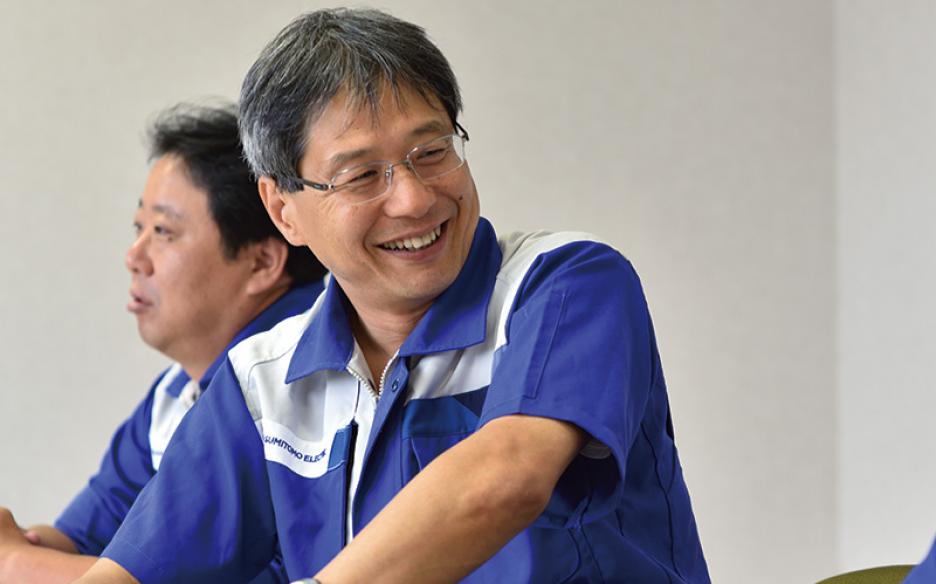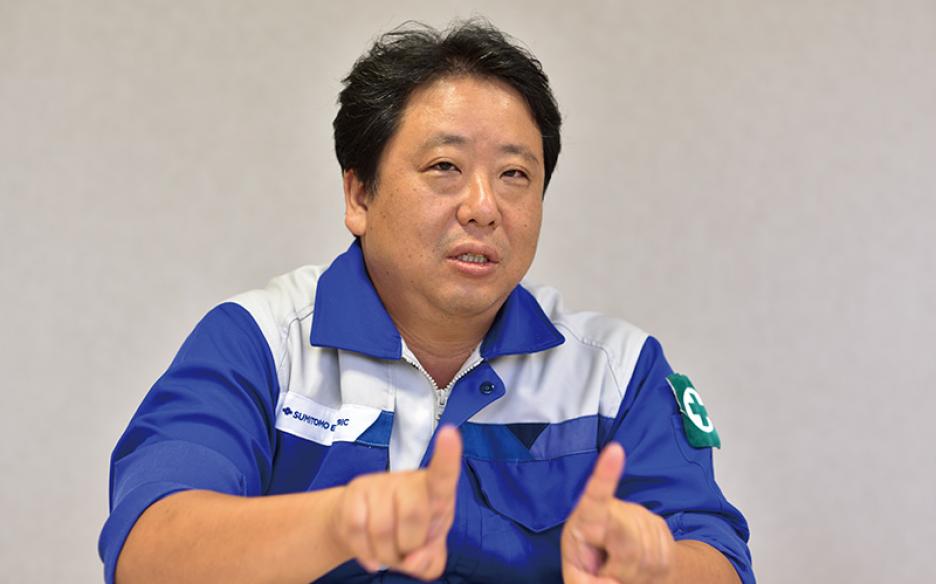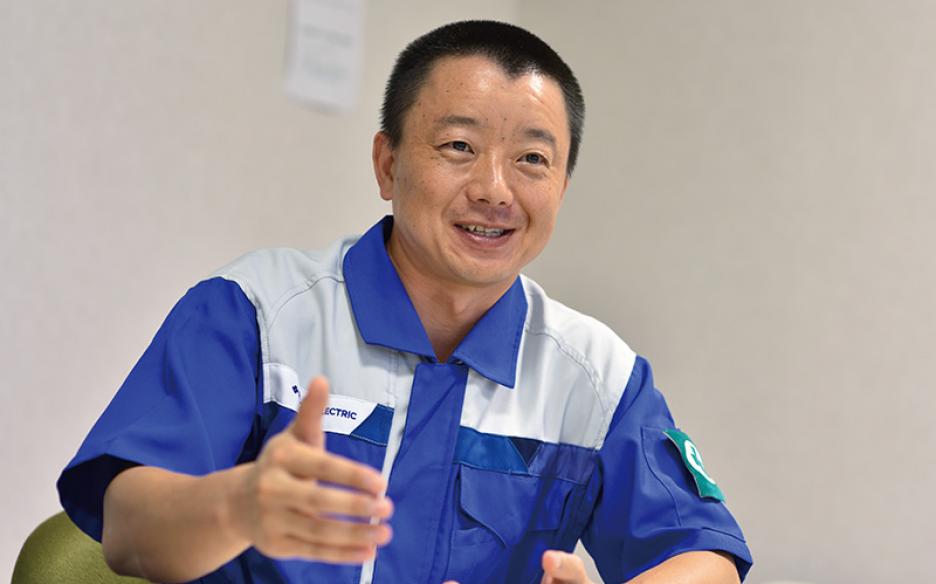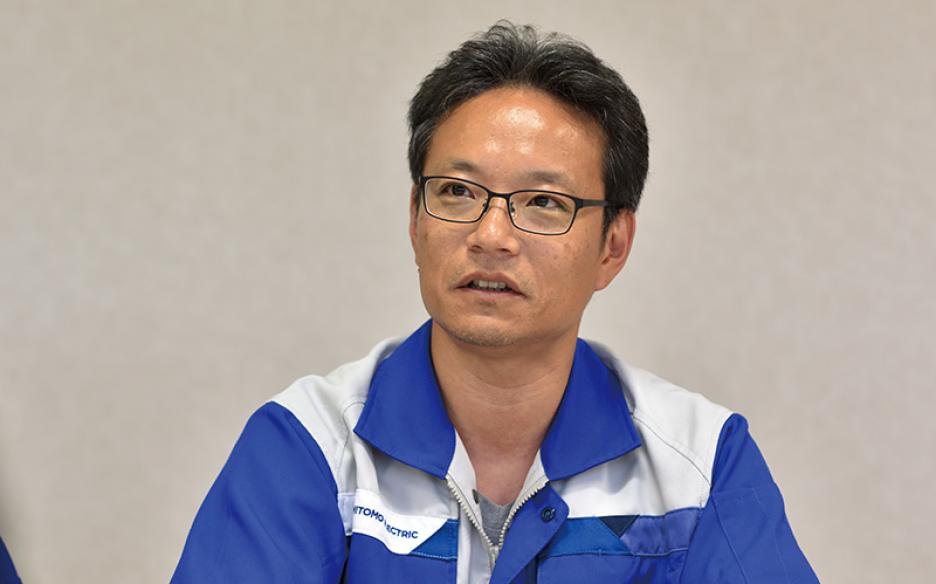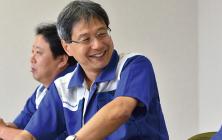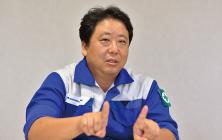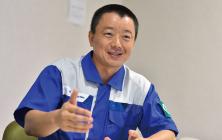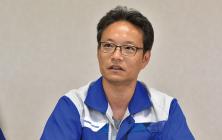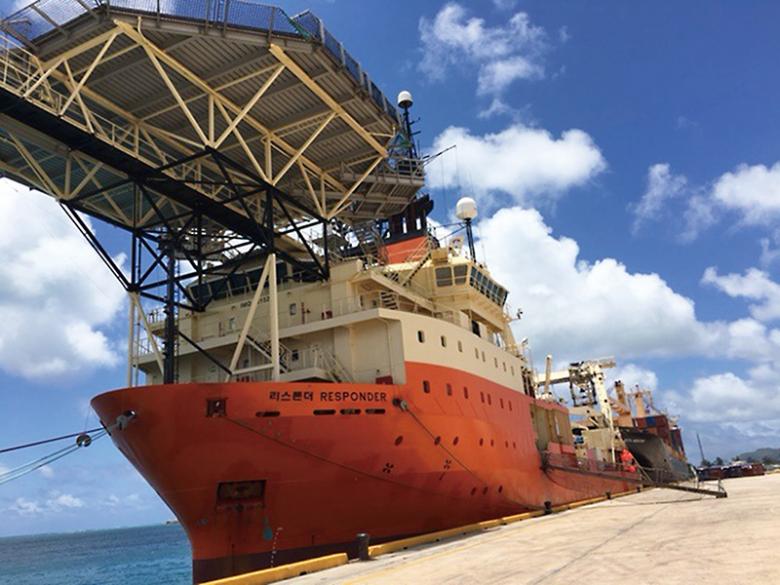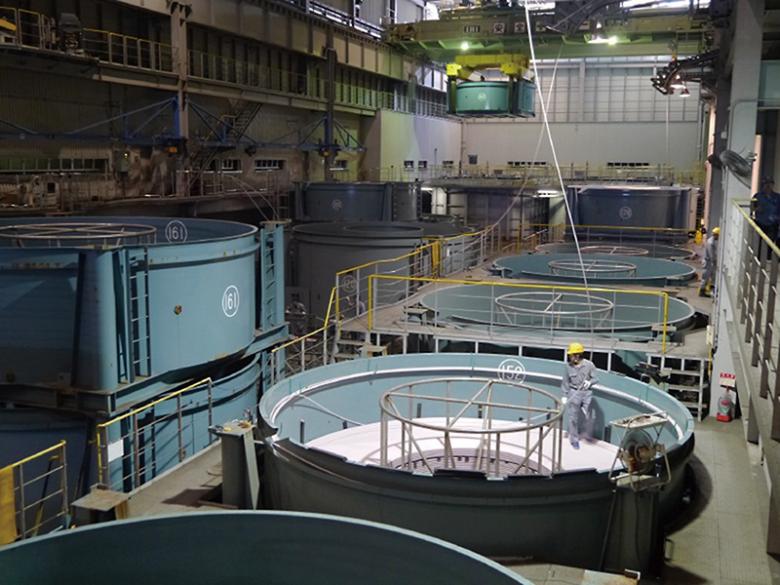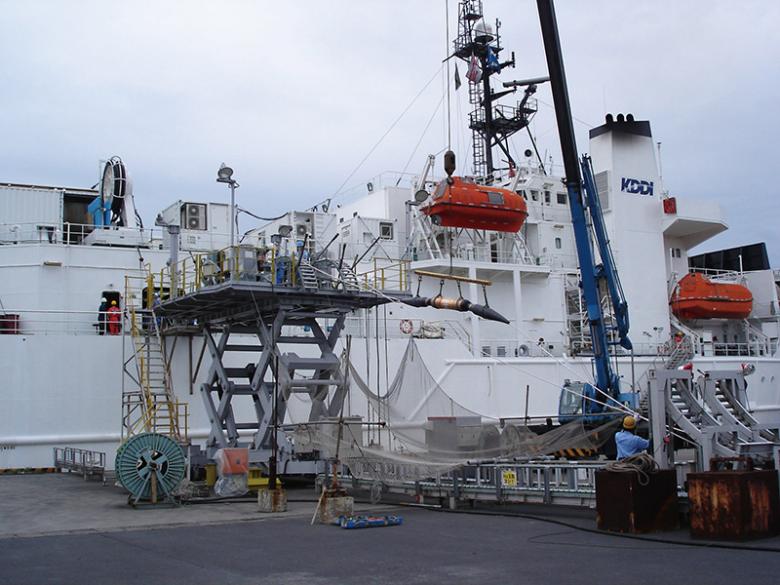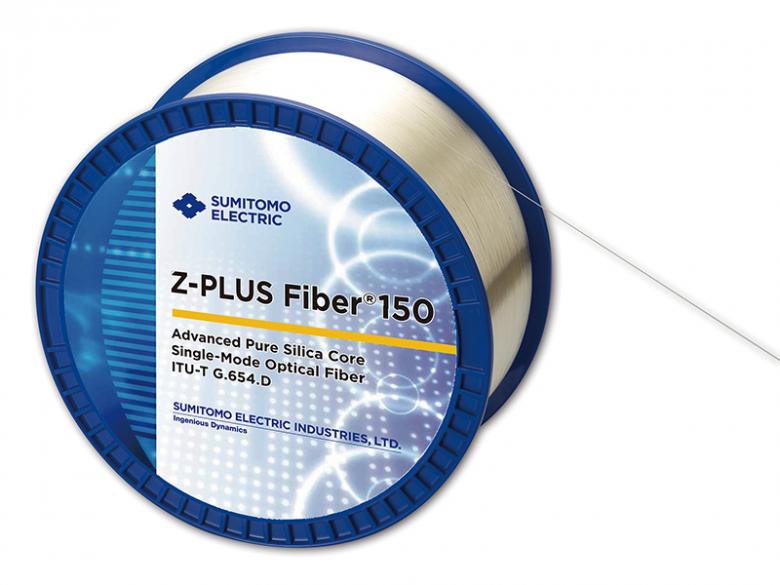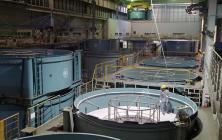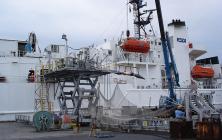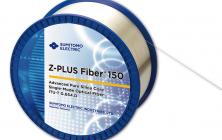
Transatlantic and Transpacific Submarine Optical Fibers
Laying a submarine cable(photo courtesy: NEC Corporation)
Taking on challenges to develop the world’s best ultra-low-loss optical fibers
Breakthrough in optical fiber manufacturing, creating the new era of optical communication
The revolutionary idea of communicating via optical fibers came up about 60 years ago. In the 1960s, full-scale research on optical fibers was launched, and in the 1970s, there was a growing momentum toward commercial implementation. Under these circumstances, NTT (then Nippon Telegraph and Telephone Public Corporation) and three cable manufacturers including Sumitomo Electric established a joint research system for optical fibers. In this process, an optical fiber manufacturing method called the vapor-phase axial deposition (VAD) Method was invented. This was an excellent technique for mass production. In the 1980s, this method was improved and advanced to a level where optical fibers of higher quality and lower loss could be mass-produced, leading to the full-fledged commercialization phase.
Optical fibers are made by heating porous silica glass rod and pulling it up in the axial direction. The key point was to make a large-diameter preform that enabled the creation of a long, thin optical fiber to help increase production efficiency.
In addition to this, high quality (i.e., low loss) optical fibers were achieved because preform made by the VAD Method contained minimal impurities. The establishment and advancement of the VAD Method were milestones in the era of optical communication.
Development of Z-fiber, a low-loss optical fiber that surprised the world
Achieving low loss, or optical attenuation improvement, was a major technical issue in establishing the VAD Method. When light is transmitted through an optical fiber, part of the light is scattered outside the fiber after a certain distance or is absorbed by impurities contained in the glass, resulting in optical attenuation. High optical attenuation makes it difficult for the optical signals to be transmitted over long distances, resulting in poor transmission with low communication quality and reliability. (An optical amplifier is used to recover the attenuated optical signals.) Thus, the achievement of low-loss optical fibers was the biggest technical challenge for the optical fiber engineering team of the Sumitomo Electric Group. Masashi Onishi, who is currently the Manager of the Planning Dept., Optical Fiber & Cable Div., was one of the engineers.
“To achieve low loss is to improve the glass transparency. In the VAD Method, we tried to remove impurities as far as possible, but germanium was an essential additive while also an impurity. An optical fiber consists of a core and cladding. There must be a refractive index difference between the core and the cladding to transmit optical signals through an optical fiber. To increase the refractive index of the core, it was inevitable to add germanium. However, Sumitomo Electric was seeking to achieve high glass purity for ultimate low loss. Thus, our predecessors made efforts to develop an optical fiber without using germanium in the core. To maintain a refractive index difference, fluorine was added to the cladding in order to reduce the refractive index, and germanium-free pure silica core optical fiber was developed. This new optical fiber was named Z-fiber and put on the market in 1986.”
The typical transmission loss of conventional optical fibers was 0.20 dB/km, while that of the Z-fiber was 0.154 dB/km on the research level and 0.17 dB/km on the product level.* This ultra-low-loss optical fiber surprised the optical communication industry.
Eventually, the engineering team found an ideal target field for their low-loss optical fibers. Low loss characteristics were particularly advantageous for long-haul communication systems, and among those submarine cable systems were the largest in scale. In 1988, optical fibers were introduced in the 8th transatlantic communications cable (TAT-8), and in 1989, in the 3rd transpacific cable (TPC-3). These developments dramatically improved communication environments, putting international telephone communication into widespread use. Technical study was continued to improve the transmission capacity further, and in 1992, the Z-fiber-based 4th transpacific cable (TPC-4) was constructed and doubled the transmission capacity compared to TPC-3. It should be highlighted that the importance of low-loss optical fiber was recognized widely although the transmission capacity improvement was achieved not only by the low-loss optical fiber but also through progress in transmitting/receiving optical devices.
* dB (decibel) is a unit of transmission loss. “0.17 dB/km” means the loss of 0.17 dB per km. The transmission loss of an entire transmission line can be estimated by multiplying it by the length of the transmission line.
Across the Pacific Ocean Coping with difficult issue chromatic dispersion
While low-loss optical fibers were used for submarine cables, a new issue started to emerge: chromatic dispersion. The wavelength of optical transmission became longer from 0.8 μm (micrometer), 1.3 μm to 1.55 μm with the progress of the semiconductor laser. In particular, the advent of the 1.55 μm band brought a significant impact. The 1.55 μm band was considered to be the most suitable band for long-haul transmission because the transmission loss of optical fibers is/was lowest in the band. The Z-fiber of the Sumitomo Electric Group was the lowest in the 1.55 μm band loss optical fiber, but its chromatic dispersion was not small enough in the 1.55 μm band. Chromatic dispersion is a phenomenon in which the speed of light transmission varies by wavelength. This causes a broadening of light pulses at some wavelengths, which in turn limits the overall number of pulses that can be sent per unit of time and thus makes large capacity transmission difficult. The Sumitomo Electric research team launched efforts to eliminate the chromatic dispersion in the 1.55 μm band without compromising the low loss characteristics.
“The question was how to control and minimize the chromatic dispersion. It was necessary to change the refractive index profile of the core and cladding by using additives and thereby change the chromatic dispersion characteristics. We worked desperately, but transmission loss increased no matter what we tried. Unfortunately, we had no choice but to give up the development.”
The use of optical fibers in submarine cables continued to expand, but they were different from low-loss optical fibers achieved by the Z-fiber. They were designed to minimize the chromatic dispersion in the 1.55 μm band by using germanium.
World’s best ultra-low-loss optical fibers achieved by a strong belief
The submarine optical fiber business of the Sumitomo Electric Group remained sluggish for about 10 years from 2002 due partly to the economic disruption in the IT industry. However, the Group made continuous efforts to develop ultra-low-loss optical fibers based on a belief, which was passed on from predecessors, that low-loss optical fibers would significantly benefit society. The situation changed completely in around 2010 due to the advent of the digital coherent technology, which was designed to receive optical signals distorted by chromatic dispersion and to compensate for the distortion by the calculation of the signal processing circuit. As this technology was set to become commercially implementable, the chromatic dispersion requirements for optical fibers were dramatically relaxed and reduction of transmission loss was strongly required. At this timing, the Sumitomo Electric Group put additional resources into the development, and the efforts bore fruit in 2013. Masaaki Hirano, who is currently working in the Market & Engineering Dept., Optical Fiber & Cable Div., was one of the key members of the development project.
“To minimize transmission loss, we focused on improving the glass transparency. In general, the refractive index of the optical fiber glass is considered to be uniform, but there is a fluctuation in reality and it is not uniform. We worked to minimize the fluctuation in the order of nanometers. We were convinced that improving glass transparency by minimizing the fluctuation was the only way to go.”
In 2013, Hirano and other members developed an optical fiber of 0.154 dB/km on a product level. Sumitomo Electric’s optical fibers attracted global attention again and the business started to recover dramatically. The development accelerated further, and in 2017, they attained a transmission loss of 0.142 dB/km on a research level and 0.150 dB/km on a product level, breaking the world record for transmission loss of optical fibers. Their successful development helped boost the shipment of low-loss optical fiber products for submarine cable projects. Eventually, Sumitomo Electric attained the top share in the global submarine optical fiber market.
Delivering unique products based on original technologies and commitment to excellence
The efforts to develop next-generation optical fibers have also been accelerating. Takemi Hasegawa, who is working in the Optical Transmission Media Dept., Optical Communications Lab., is one of the members.
“At our laboratory, the development of ultra-low-loss optical fibers is a never-ending theme. We will break the world record again and again in the course of meeting customers’ needs at improved costs and productivity. Meanwhile, the transmission capacity of an optical fiber is reaching its theoretical limit. To cope with this issue, we will take on challenges to develop new products such as multi-core optical fibers with a larger number of cores.”
Yasushi Koyano, who works for both the Optical Fiber & Cable Div. and the Optical Communications Lab., closely monitors R&D activities and market trends. He is responsible for increasing the presence of the Sumitomo Electric Group in the global optical fiber market.
“It is important to visit customers and hold interviews with the future vision in mind. Obviously, low loss is the key technology of Sumitomo Electric’s optical fibers, but customers ask for both quality and reduction in total cost. We hope to lead in technologies and offer best optical fibers for customers. We will actively open up new markets in the world.”
The Sumitomo Electric Group’s optical fibers have a history for about 40 years. Onishi says: “Many predecessors never gave up on development.” Their commitment and belief have been successfully passed on to us. The steady efforts to create unique products based on original technologies will open up the future.

Registration of public notification
If you register your e-mail address, we will notify you when the latest issue is published. If you wish, please register from the registration form.
To delete your registration, please visit here.
